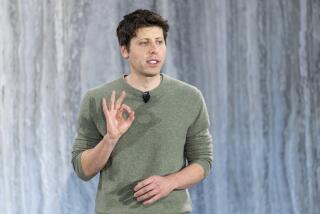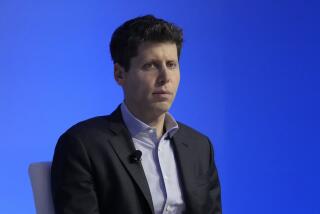Traders Aren’t Buying AST’s Vision of Future : Market: Shares of Irvine computer maker lose another 10% after analysts reject prescription for turnaround.
- Share via
IRVINE — Nervous traders, upset with the prospect of a fifth straight quarterly loss by AST Research Inc., rebuked company efforts to ease their concerns and sent shares in the computer maker tumbling nearly 10% Tuesday in heavy trading.
In a morning telephone conference call, AST executives tried to reassure industry analysts that the Irvine manufacturer is coming to grips with a series of production and marketing problems that have sent AST into a tailspin. Still, the stock lost $1.25 a share to close at $11.50 a share in Nasdaq trading that was 11 times greater than its recent daily average.
“They didn’t tell us anything interesting. There was nothing earth-shaking,” said Bret Rekas at Donaldson, Lufkin & Jenrette in New York. “I’m not recommending the stock.”
Tough talk from analysts, though, isn’t unnerving Safi U. Qureshey, AST’s chairman and co-founder. He’s talking tough himself.
“We really have to pick up speed in our decision-making,” Qureshey said Tuesday. “I think we have to show good improvement every quarter, starting with the next quarter. We cannot continue to live with this performance.”
Qureshey said he’s even willing to give up his daily duties as chief executive if the company can find a strong, seasoned manager to be president and chief executive. AST lost its president and chief operating officer, James T. Schraith, in a management shake-up Monday. For about 40 minutes Tuesday, Qureshey and other AST executives talked with analysts to elaborate on Monday’s news about the shake-up and an anticipated quarterly loss that will be “significantly higher” than the $40 million lost in the same three-month period last year. The company lost more than $100 million in its last fiscal year, which ended July 1.
But the company’s attempt Tuesday to calm traders’ fears wasn’t a big success. AST executives basically rehashed old information about its slow-to-market production problems and other woes and were short on solutions, analysts said.
“They certainly recognize the gravity of the situation,” said William J. Milton, an analyst at Brown Brothers Harriman in New York. “If plans are not in place to revive the company, they are rapidly being formulated.”
The company, which has prided itself on designing and making its own computer system, will start turning to outside vendors such as Intel Corp. to make more advanced components. With little fanfare and no public notice, AST started buying motherboards--the computer’s basic component--from Intel for one of its personal computer lines earlier this year. Qureshey wants to expand that arrangement to cover its desktop computers and network products.
“We have to focus more on marketing and service and sales, and de-emphasize designing and manufacturing,” he said. “We need to pick up speed in developing more outsourcing. We don’t have to design everything. Others can do it more cost effectively.”
Such “outsourcing” is designed to help AST get products to market faster, which has been a serious problem for several years. Still, analysts doubt that the move will help it regain its sales momentum any time soon. The world’s fifth-largest computer maker last year, the company already has slid to seventh-largest.
The management shake-up came a little more than a month after South Korea’s Samsung Electronics Co. Ltd. became AST’s largest single shareholder and promptly urged the embattled firm to hire a management consulting company to review its operations and management. AST hired Boston Consulting Group to get the company back on track.
“This [talk with analysts] was our first message that went out after Samsung came on board,” Qureshey said. “We have a lot of work to do internally [like] procurement plans with Samsung. Rightfully, people outside are waiting for us to perform.”
Analysts say the company has a long way to go.
“They have a myriad of problems,” Milton said. “The mistakes this company has made, it’s a mess.”
He said AST has too many product brands, which confuses consumers, and the products are poorly marketed. “The customer has not been given a good reason to buy AST,” he said. In addition, the company has spent more time marketing and developing brand allegiance in Asian Pacific and third-world countries than it has in the United States.
AST also was slow this summer to respond to price cuts initiated by Compaq computers, partly because its own manufacturing costs are relatively high. It also has been slower than others to switch over to Intel’s fast Pentium microprocessor and “to nurture its relationship with Intel,” Milton said.
“A big part of the problem was that AST wanted to be another Compaq by designing their own process,” said Eugene G. Glazer, a Dean Witter Reynolds analyst in New York. “But Compaq is a powerful, fast-moving target. By sheer size, it could afford to execute its plans. AST couldn’t do that.”
Glazer said AST’s decision to buy more components, especially Intel’s motherboards, is a “reasonable approach” to resolving its problems.
Samsung, meantime, said in a news release from Seoul that it supports the changes at AST, including the resignations of Schraith and two other executives. “Samsung invested in AST looking toward a long-term benefit, fully aware that the company was in a period of adjustment,” the statement said.
The executives who resigned could not be reached for comment. But Gerald Devlin, who was named senior vice president of sales for the Americas, shed some light on why he returned to that post after giving it up and leaving the company just one year ago.
“I wouldn’t have come back,” Devlin said, “if I didn’t believe this was a situation that could be turned around.”
(BEGIN TEXT OF INFOBOX / INFOGRAPHIC)
Heading Down
AST’s stock dropped $1.25 Tuesday after a projected first-quarter loss was announced. The stock was valued as high as $18 in June. Weekly closing stock prices:
June
June 2: $18.13
June 9: $17.44
June 16: $17.38
June 23: $17.63
June 30: $15.50
July
July 7: $16.38
July 14: $15.63
July 21: $15.38
July 28: $15.88
August
Aug. 4: $15.00
Aug. 11: $13.63
Aug. 18: $14.00
Aug. 25: $13.75
September
Sept. 1: $13.32
Sept. 8: $13.00
Sept. 11: $12.75
Tuesday’s close: $11.50
Source: Dow Jones; Researched by JANICE L. JONES / Los Angeles Times
More to Read
Inside the business of entertainment
The Wide Shot brings you news, analysis and insights on everything from streaming wars to production — and what it all means for the future.
You may occasionally receive promotional content from the Los Angeles Times.










